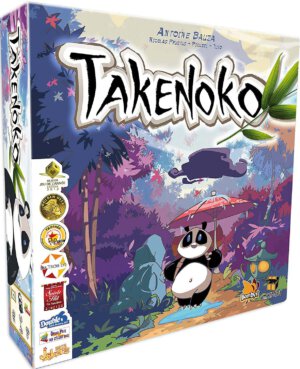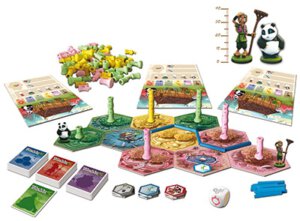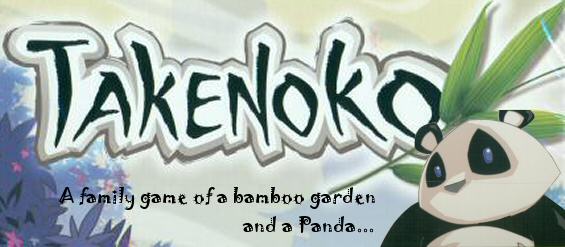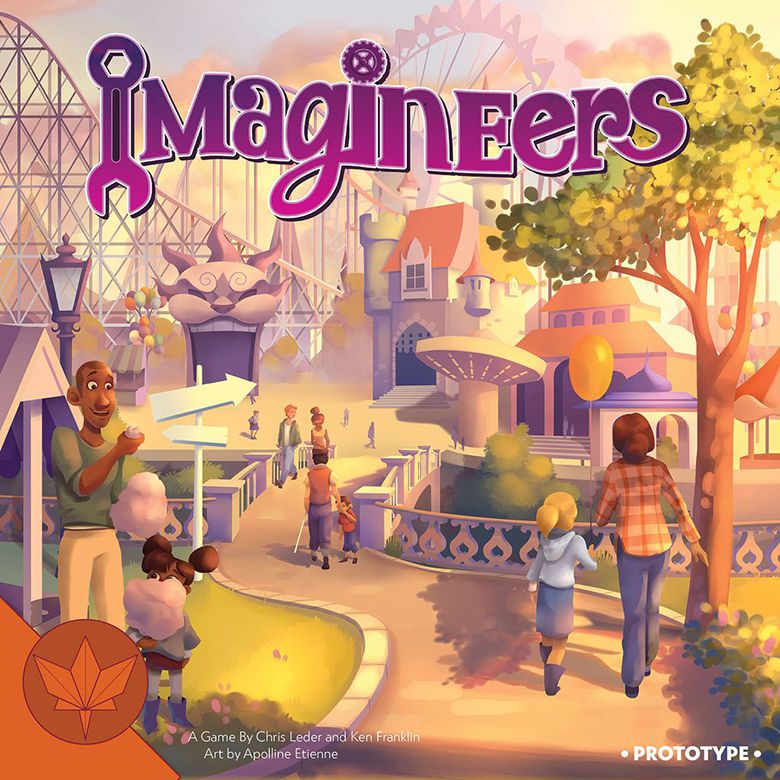
Publisher: Asmodee Editions
Designer: Antoine Bauza
Artists: Nicolas Fructus, Picksel, and Yuio
Year: 2011
Players: Two to four players
Ages: 8+
Playing Time: 45 Minutes
Genre: Tile Laying Style Family Game
Retail Price: $49.99
A long time ago, at the Japanese Imperial court, the Chinese Emperor offered a Giant Panda bear – symbol of peace to the Japanese Emperor. Since then, the Japanese Emperor has entrusted his court members (the players) with the difficult task to take care of the animal by setting up his bamboo garden. Takenoko is for two to four players and the participants will have to cultivate the land plots, irrigate them and grow one of the three species of bamboo (green, yellow and pink) with the help of the Imperial gardener. The best player will be congratulated by the Japanese Emperor himself!
What initially drew me to Takenoko was the fact that Antoine Bauza designed it. As 7 Wonders was one of the first titles to be a winner with both myself and my girlfriend, I was curious to see what this very colorful game was all about.
In Takenoko, players act as royal gardeners who work for the emperor of Japan. They will be attempting to simultaneously cultivate the beautiful bamboo garden and care for a giant panda, which the emperor received as a gift from the emperor of China. To do this, players will be placing tiles of three different colors: pink, yellow, and green. Players spend their turn irrigating these tiles, growing three different colors of bamboo, moving the imperial gardener, and feeding the giant panda. Players will also have to react to the randomness of a weather die. At the end of the game, the Emperor will come to judge how well each gardener cared for the panda as well as how much each gardener contributed to the garden.
Each player’s turn is simple. First, roll the weather die and execute the result. Then, commit two actions (not the same one twice). Score any objective cards she may have achieved, then pass the weather die to the next player.

After rolling the die, and executing the result, players will commit two actions. There are five choices and, unless the player rolled wind, she cannot choose the same action twice.
Players may take these actions:
1. Place a Tile – the player draws three land tiles from the top of the face down stack, chooses one to place, and puts the remaining two face down on top of the stack. the player must place the tile so that it is either touching two land tiles, or the starting tile. If the tile just placed is irrigated, it immediately grows a bamboo of its color.
2. Move the Gardener – the player can move the imperial gardener as many spaces as she wishes in a straight line from where he is standing. If the space where the gardener ends on is irrigated, it immediately grows a bamboo piece (up to a max of four). Any land tiles that are immediately adjacent to, irrigated, and the same color of the tile the gardener stopped on also grow.
3. Take an Irrigation stick – the player can take an irrigation stick from the supply. These can either be stored on the player’s board for later, or placed immediately. Multiple irrigation markers can be placed on a single turn, and this does not require an action. Irrigation markers are placed along the edges of the land tile hexes and must be linked (like a train) back to the starting tile (which is a pond).
4. Move the Panda – the player can move the panda as many spaces as she wishes, in a straight line. If the land tile the panda ends on has bamboo, the panda will eat one piece. The player places this piece on her player mat and will be used for scoring purple panda objective cards (more on this below).
5. Collect an Objective card – the player can draw one objective card from one of three decks. The blue deck is land tile objectives – players will score victory points when certain color land tiles are laid out on the table in certain configurations. The red deck is gardener objectives – players will score points when certain color bamboo shoots reach certain heights. The last deck is the purple panda deck – players score point with these cards by having specific combinations of bamboo on their player mat.
As soon as a player’s objective card is completed, either by herself or another player (as can sometimes happen with the red and blue cards), she may play her completed objective card down to the table.
The game ends when any player has completed a certain number of objective cards, depending on the number of players playing; nine cards for a two player game as an example. Once one player reaches the objective card threshold, the current game round will end. Whoever triggered the end of the game will receive a special two point Emperor card! Players add up the points on the objective cards they were able to complete and the most total points wins!

Takenoko is a delightful game! The rules are simple, and yet there is still room for some decision making. One factor that creates more interesting decisions is that there are not an equal number of each color land tile. Greens are the most common, followed by yellow and then red. This rarity is reflected in the objective cards, which are valued accordingly – cards dealing with green land or bamboo are worth less, yellow slightly more, and red the most.
Adding to this very pleasant, easygoing gaming experience, is the quality of the components included with Takenoko. From the cards, to the tiles, to the figures, to the awesome stackable bamboo pieces, the quality of the components in Takenoko is nothing short of superb. Everything in the box is beautiful to behold, with wonderful art and bright colors throughout. And the insert? Oh my goodness what an insert! It is perfectly molded to fit everything in the box snugly, and looks fantastic. One detail that blew me away is there are three basins in the insert used to store the awesome bamboo pieces. These basins have a sloped side instead of square, so that scooping the pieces out is much easier. How cool is that?
Antoine Bauza has created another unique game very suitable for families. Surely this entry will not generate much buzz, as it is decidedly lighter fare than his previous efforts but Takenoko is a fun, short, light game of interesting, but never taxing, decisions. The simple gameplay would not be terribly noteworthy on its own, but the sheer beauty and quality of the components makes Takenoko a wonderful example of why table top gaming stands apart from video games.
[rwp-review id=”0″]
- Titan Comics for February 21st, 2018 - Feb 17, 2018
- The Gardeners and the Panda?: A Review of Takenoko - Jan 25, 2012
- You Made a Time Machine Out of a DeLorean? Back to the Future – The Card Game Reviewed - Jan 8, 2012

















